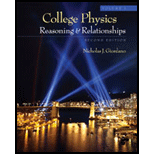
Concept explainers
(a)
The acceleration due to gravity at a height
(a)
Answer to Problem 71P
The acceleration due to gravity is
Explanation of Solution
The gravitational force of an object on the Earth’s surface is determined by Newton’s universal law of gravitation. Which is given by,
Here,
Force of gravity is the only force acting on the station so that for an object in orbit it must be providing the entire centripetal acceleration,
The acceleration of the station when it is moving in a circle must be centripetal acceleration which is given by,
The expression for the time period is given by,
Conclusion:
The orbit of the station is equal to Earths radius plus height above the surface so that,
Substitute
Substitute
Substitute
Therefore, The acceleration due to gravity is
(b)
The orbital velocity and period of the telescope.
(b)
Answer to Problem 71P
The orbital velocity is
Explanation of Solution
Substitute
Conclusion:
Substitute
Therefore, The orbital velocity is
Want to see more full solutions like this?
Chapter 5 Solutions
College Physics, Volume 1
- The astronaut orbiting the Earth in Figure P3.27 is preparing to dock with a Westar VI satellite. The satellite is in a circular orbit 600 km above the Earth’s surface, where the free-fall acceleration is 8.21 m/s2. Take the radius of the Earth as 6 400 km. Determine the speed of the satellite and the time interval required to complete one orbit around the Earth, which is the period of the satellite. Figure P3.27arrow_forwardCheck Your Understanding Assume you are in a spacecraft in orbit about the Sun at Earth’s orbit, but far away from Earth (so that it can be ignored). How could you redirect your tangential velocity to the radial direction such that you could then pass by Mars’s orbit? What would be required to change just the direction of the velocity?arrow_forwardThere are two spaceships that orbit the Earth. If the orbital radius ratio of the two spaceships is 2, what is the ratio of speed, acceleration and cycle of these two spaceships?arrow_forward
- You are designing a communications satellite to be placed in circular orbit around theEarth with a period of 8.00 hours. Recall that the mass and the radius of the Earth areME = 5.97 × 1024 kg and RE = 6.37 × 106 m.(a) At what height above the surface of the Earth should the satellite be placed?Give your answer in units of kilometers (km).(b) What is the orbital speed of this satellite, in km/s?arrow_forwardA objectwas thrown on a sufficiently large inclined plane at time t = 0 with velocity v0 = 10 (m/s) as shown in the figure. Find the radius of curvature of the object's orbit after 1 second.arrow_forwardAn artificial satellite circles the Earth in a circular orbit at a location where the acceleration due to gravity is 9.065 m/s2. Determine the orbital period of the satellite? Your answer should be a unit of time.arrow_forward
- Suppose we launch a satellite in a circular orbit, and want it to revolve once around every 2 hours? How far above the surface of the Earth should this satellite be placed? Report your answer in Earth radii. (Neglect the presence of the moon).arrow_forwardThe International Space Station orbits the Earth in a circle with a radius of approximately 6688185 m (which is only a few hundred miles above Earth's surface). At that distance, the acceleration due to gravity is only 8.87m / (s ^ 2) what is the velocity of the space station in this orbit? Your answer should be in units of m / sarrow_forwardYOU WISH TO PUT A 1000-KG SATELLITE INTO A CIRCULAR ORBIT 300 KM ABOVE THE EARTH'S SURFACE. WHAT SPEED, PERIOD AND RADIAL ACCELERATION WILL IT HAVE?arrow_forward
- A satellite orbits the Earth in an elliptic orbit with eccentricity 0,3. Itspericentric height is 150 km. What is its velocity at a height of 300 km?If its speed at perigee is decreased by 10%, still perpendicular to theradius, determine if if it will stay in an orbit or hit the Earth.arrow_forwardSatellites that orbit at an altitude of 438 mil above the surface of earth are called sun-synchronous because the position directly below the satellite is always at the same time of day. Given their altitudes, what must be their periods of revolution?arrow_forwardTwo planets in circular orbits around a star have speeds of v and 7v. (a) What is the ratio of the orbital radii of the planets? rv r7v = (b) What is the ratio of their periods? Tv T7v =arrow_forward
 University Physics Volume 1PhysicsISBN:9781938168277Author:William Moebs, Samuel J. Ling, Jeff SannyPublisher:OpenStax - Rice University
University Physics Volume 1PhysicsISBN:9781938168277Author:William Moebs, Samuel J. Ling, Jeff SannyPublisher:OpenStax - Rice University Classical Dynamics of Particles and SystemsPhysicsISBN:9780534408961Author:Stephen T. Thornton, Jerry B. MarionPublisher:Cengage Learning
Classical Dynamics of Particles and SystemsPhysicsISBN:9780534408961Author:Stephen T. Thornton, Jerry B. MarionPublisher:Cengage Learning Principles of Physics: A Calculus-Based TextPhysicsISBN:9781133104261Author:Raymond A. Serway, John W. JewettPublisher:Cengage Learning
Principles of Physics: A Calculus-Based TextPhysicsISBN:9781133104261Author:Raymond A. Serway, John W. JewettPublisher:Cengage Learning


